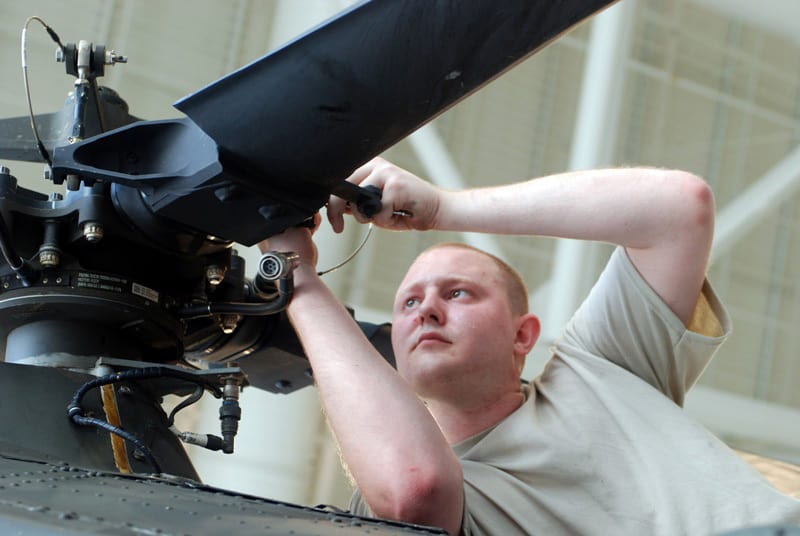
Every helicopter should have had some form of inspection before it gets airborne. This can be something as simple as a quick walk around with a visual inspection, all the way to a complete overhaul of the entire aircraft. The question is how often do inspections need to happen and how do the owners and mechanics/engineers know when to do them?
Daily, every 25, 50, 100, 150, 600 hours & annual inspections are common maintenance schedules a helicopter can be flown between each maintenance inspection. The manufacturer and the FAA stipulate how often and how in-depth a helicopter needs to be inspected by qualified helicopter engineers.
As part of my pre and post-flight routine, I have to visually inspect certain parts of the helicopter to ensure it is safe to fly. To further increase safety, the helicopter is required to be inspected by certified helicopter mechanics at varying intervals of its life to ensure components and the aircraft structure are still airworthy and in good condition. Similar to taking your car in for an oil change, a helicopter is no different, although the price tag of a helicopter service has a few more zero’s after them!
To find out more about when a helicopter gets maintenance read on…
What is a Helicopter Daily Inspection?
This is a visual inspection of the helicopter completed by a pilot or mechanic before it flies for the day. This inspection can be completed during that day before it flies, or after the last landing of the day so it is ready for the next flight. This ensures it is safe for its next flight.
The most common inspection on a helicopter is the Daily or Pre-Flight Inspection.
When helicopters fly out of the hangar or are out in the field a dedicated mechanic/engineer may be assigned to the company’s helicopter/s to complete the maintenance inspections after the pilot/s have finished flying for the day. For those of us pilots that don’t have the luxury of a dedicated maintenance engineer, we have to complete the visual inspection ourselves. Depending on the timeframe I usually complete the visual inspection the night before or before the flight depending on which suits me better. To be able to complete a visual inspection as a pilot I have to be trained and signed off as competent.
To help pilots complete a thorough visual inspection of the aircraft the manufacturers create a checklist of items to look at as you walk around the aircraft in a logical manner.
Each helicopter is different so guidance from the manufacturer is a great starting point. Also when transitioning onto a new aircraft most maintenance engineers that are familiar with that particular helicopter will give the pilot a thorough walk-through to ensure the pilot knows what to keep an eye on, what needs touching, and what needs draining or sampling.
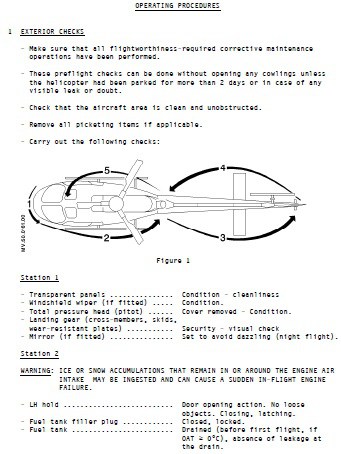
Most daily inspections will involve opening up each access panel and checking for fluid leaks, chafing of wires, loose nuts & bolts, missing hardware, broken or cracked components, and any items that should not be in there (ie: tools and rags left over from a sloppy maintenance mechanic or another pilot). A good inspection should take anywhere from 10-15 minutes to a couple of hours depending on the size and complexity of the helicopter and how many sets of eyeballs are looking at it.
During this inspection, most good pilots/mechanics will also be wiping the components and areas free from oil, dust, and debris to keep the machine clean and make it easy to see any cracks appearing. By looking under an access panel in a helicopter you can get a really good impression of how well the company and its employees look after their equipment! – I’ve seen some shockingly dirty aircraft!

Join My Newsletter & Get Great Tips, Information and Experiences To Help You Become a Superb Pilot!
What are Helicopter Hourly Inspections?
Each hour a helicopter flies it accumulates towards a maintenance inspection. Common intervals of 25, 50, 100, 300, and 500 hours give engineers the chance to inspect different parts of the helicopter to check for wear and integrity. The hourly maintenance schedule is created by the manufacturer.
The more hours a helicopter flies, the more in-depth each inspection becomes. As the hours accumulate the inspections involve different parts of the helicopter being removed and inspected more thoroughly than just a visual inspection.
For example, once a helicopter has flown for 150 hours it gets inspected and signed off for another 150 hours at which point it gets inspected again and signed off again for another 150. The next maintenance target it hits will be a 600 hour inspection which makes the engineers look at a deeper level to check for component wear etc.
Flight hours are cumulative and the different types of maintenance inspection vary by helicopter type. Each helicopter manufacturer has to create a maintenance program for its helicopter as part of its certification process. Based on test data and the history of components used on its other helicopters, the manufacturer can predict at what time a certain component needs to be inspected, adjusted, or replaced.
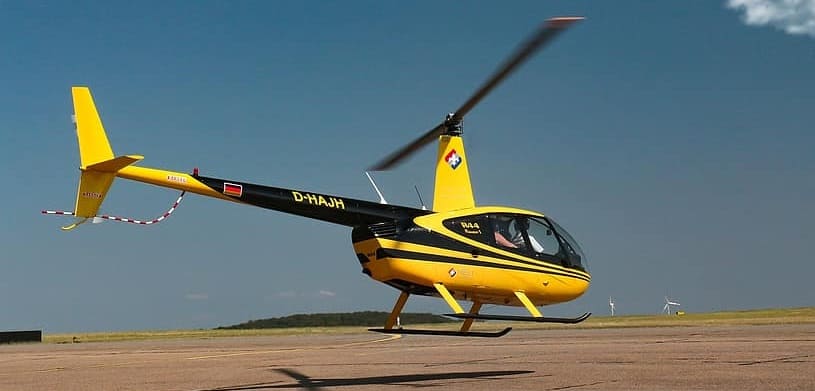
The Robinson R44 is one of the worlds most popular helicopters and here is an example of its hourly inspection program:
First 25 Hours:
Change oil and filter and inspect oil suction screen and filter
Check the alternator belt tension
Every 50 Hours:
Inspect & service engine per Engine Operator’s Manual
Change oil, oil filter, and inspect oil suction screen and removed filter
First 100 Hours:
Drain and flush gearboxes
Check engine exhaust valve guide clearance
Every 100 Hours:
Inspect and service engine per Engine Operator’s Manual
As required, inspect and service ignition components
Every 300 Hours:
Lubricate C181-3 bearing
Replace hydraulic filter
Inspect valves and check engine exhaust valve guide clearance
Every 500 Hours:
Drain and flush gearboxes
Clean gearbox chip detectors
Verify magneto drive cushion pliability
Service collective spring assembly (manual controls only)
As required, inspect and service ignition components
Every 2200 Hours:
Overhaul entire helicopter
See R44 2200 Hour Inspection
Just like a vehicle, as the helicopter gets older its components begin to wear more, and seals, hoses, belts, and bearings can begin to degrade. By having a maintenance plan of what the engineer needs to inspect at hourly stages allows for simpler budgeting and planning when it comes to the maintenance service.
The more in-depth the inspection becomes, the longer it takes to be completed and when certain components need to be replaced the costs can soon begin to rise. The average cost for a 100 hour inspection on the Robinson R44 costs around $1500.
What are Helicopter Calendar Inspections?
No matter how old a helicopter is it contains components that must be replaced upon reaching their maximum age limit regardless of how many hours that helicopter has flown. Components subject to atmospheric degradation and fatigue will be given a calendar time limitation by the manufacturer.
Most calendar inspections on a helicopter fall under an Annual Inspection where the helicopter gets a thorough inspection once per year regardless of how many hours it has flown or can have a calendar maintenance schedule in addition to an hourly maintenance schedule set forth by the manufacturer.
During these calendar inspections, many pieces of the helicopter’s equipment get inspected or calibrated based on their calendar due date, just like the hourly maintenance schedule.
For example, the Robinson R44 has items that need to be inspected both hourly and per the calendar:
Every 4 Months:
Change oil, oil filter, and inspect oil suction screen and removed filter
Every 12 Months:
Inspect per Section 2.400 of the Maintenance Manual
Clean gearbox chip detectors
Inspect emergency locator transmitter (ELT)
Inspect optional pop-out floats
Every 24 Months:
Test and inspect transponder
Every 3 Years:
Lubricate C181-3 bearing
Inspect optional popout floats
Hydrostatic test pressure cylinder
Every 4 Years:
Overhaul TCM magnetos
Verify magneto drive cushion pliability
Every 12 Years:
Perform 12-year inspection and limited overhaul per Section 2.600, or overhaul per Section 2.700.
When it comes to the aircraft components, just like the hourly maintenance schedule the components and their calendar life limit change by each helicopter type and manufacturer. Some helicopters have a maximum time limit on main rotor blades for example, whereas other manufacturers place no time limit on them.
Here is an example of the Time Limited Components on the Robinson R44:
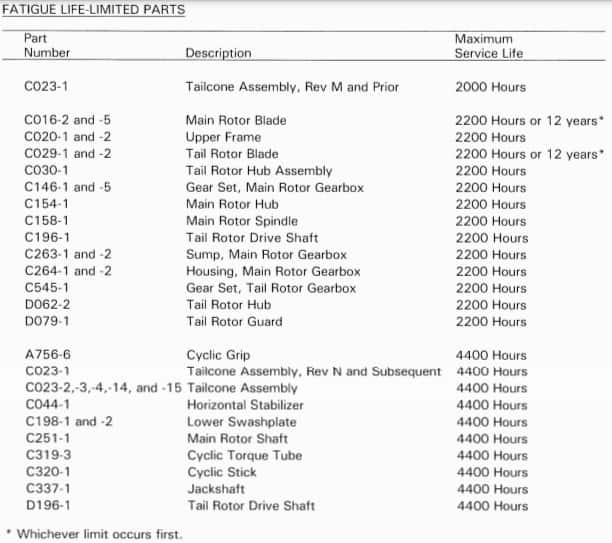
As you can see, many components have an hourly time limit that once they reach they need to be replaced, regardless of their condition. If you look at the main and tail rotor blades they also have a calendar limit of 12 years. Whichever limit is reached first is when they must be replaced: 12 years or 2200 hours.
If an owner were to purchase an R44, fly it from the factory to their hanger and leave it there. After 12 years they would need to replace both the main and tail rotor blades, even though they may only have 20 hours on them. This is because the manufacturer has stipulated that after 12 years they cannot guarantee the integrity of the blade therefore it must be replaced regardless of its condition.
The AS350 Astar that I currently fly has no calendar-limited components (that I’m aware of) so everything is replaced either when deemed out of tolerance by the maintenance engineers in consultation with the manufacturer’s recommendations, or it breaks.
Again, every manufacturer is different and the maintenance schedule and cost are something that must be researched by the purchaser to ensure they do not get caught out when the maintenance bills begin to arrive.
If you wish to see just what is involved in an annual inspection on a Robinson R44 helicopter you can view the engineer’s checklist HERE – Be sure to start at page 2.13
What are Helicopter Airworthiness Directive Inspections?
When a helicopter manufacturer has a concern about a certain component it can issue an Airworthiness Directive (AD). This directive must be complied with as per the terms set out by the manufacturer and usually involves a visual inspection and a signature in the aircraft logbook to state it has been complied with.
For example, there could have been a crack found appearing in a certain area of a component on several of its helicopters. To keep everyone safe, the AD gets issued with a checklist of what needs to be done and how often. This AD must be completed and signed off by an approved person (Pilot or Engineer) or the aircraft is deemed unairworthy thus nulling its insurance policy.
I have two AD’s on my Astar at the moment to inspect the tail rotor pitch change links for excessive wear and ensure the witness marks are legible on the main rotor pitch change links. Each has to be done as per the recommended times set forth by Airbus. As I do my daily inspection, I follow the AD’s when I’m looking at the main and tail rotors anyway, then I sign the aircraft’s logbook to say the aircraft’s daily inspection is complete as well as the AD’s.
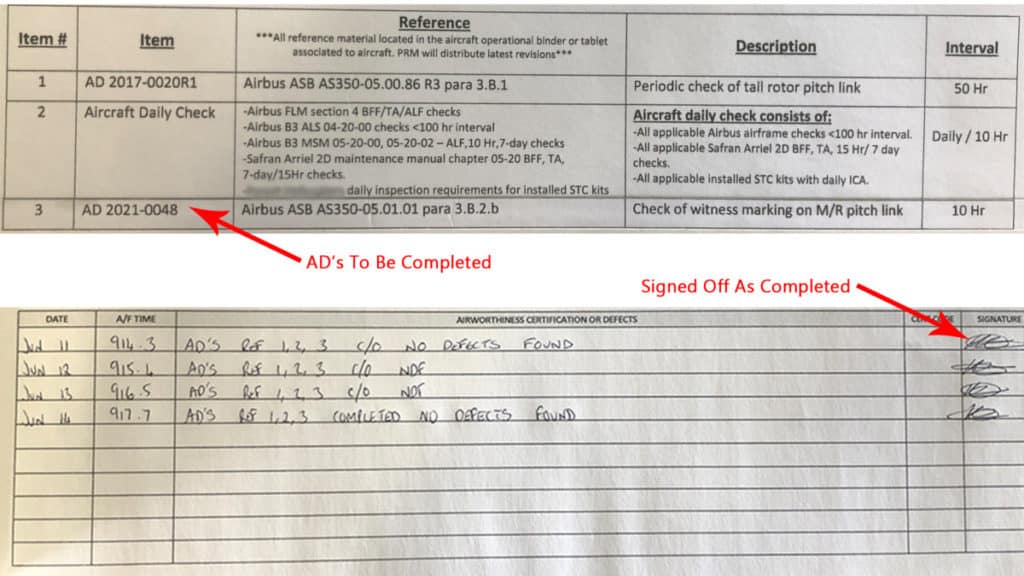
Now it’s been inspected and signed off, I can legally go and fly the helicopter for that day.
AD’s are issued every now and then to help keep occupants safe when the manufacturer wishes to keep a close eye on a certain part of its helicopter. Most of the time there is no issue, but paying special attention to a certain component helps spot any potential problems arising before they turn into a major issue. Once a manufacturer is satisfied there is no issue they can remove the AD.
To Finish
By following the set maintenance schedule program set out by the manufacturer it ensures the helicopter is kept as safe as it possibly can. A visual inspection on a daily basis before the aircraft flies is a great way to ensure everything is as it should be, fluid levels are correct and nothing has been left behind by yourself or another person.
As helicopters begin to age the maintenance schedules are an excellent way to keep an eye on known wearing components and get them replaced before they develop into an issue that can, and has been deadly if not addressed.
Further Reading
If you found this article helpful may I suggest a few more for you to read:

